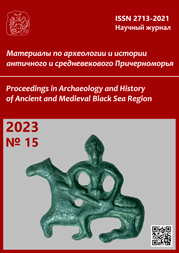Некоторые особенности культа Диониса у эллинов и варваров Северного Причерноморья
Some features of the cult of Dionysus among the Hellenes and barbarians of the Northern Black Sea region
Author(s): I.Yu. SchaubSubject(s): History, Cultural history, Customs / Folklore, Ancient World, Cultural Anthropology / Ethnology
Published by: Нижневартовский государственный университет
Keywords: North Pontic area; Greeks; barbarians; religion; cult; Dionysus; Sabazios; satyrs; maenads; ‘Master of Beasts’; Great Goddess; Orphism; Thrace; Olbia; Bosporus; Chersonesus;
Summary/Abstract: The article is devoted to the peculiarities of the cult of Dionysus in the Greek colonies of the Northern Black Sea region, as well as the specificities of Dionysianism among local barbarians. These features were largely due to Thracian influences: in Olbia, they are primarily evidenced by Orphic tablets, in the Bosporus — the exceptional popularity in local numismatics of images of satyrs borrowed from Thrace, the cult of Dionysus Ares, as well as the unusual image of the chthonic Dionysus on funeral pelicеs. Both in the Bosporus and in Chersonesus, the Thraco-Phrygian god Sabazios, who was close to Dionysus in function, belonged to the circle of this god. On the coins of Panticapaeum, the combination of images of satyrs on the obverse with an Apollinian griffin on the reverse enables suggestion of the fusion of Dionysus and Apollo in the context of Orphic beliefs as well as in the religion of the Bosporans. In the Bosporus, the Dionysian circle is associated not only with a number of gods close to the cult of Dionysus in other areas of the Greek world (Demeter, Kore, Heracles, Aphrodite, and Eros), but also mythological characters not associated with him (Paris, Europa, etc.). Finds in the burial mounds of the Scythian and Sindian nobility of various cult-related artifacts, often with images of characters of the Dionysian circle, indicate the closeness of the latter to the religious and mythological ideas of the barbarians. This circle also includes the male counterpart of the snake-footed hypostasis of the Great Goddess (‘Master of Beasts’), which appears on several monuments and which, like other Dionysian characters, was thought of as a subordinate deity to her.
Journal: Материалы по археологии и истории античного и средневекового Причерноморья
- Issue Year: 2023
- Issue No: 15
- Page Range: 701-735
- Page Count: 35
- Language: Russian

